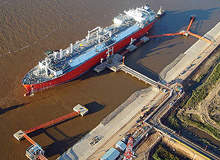
Escobar LNG terminal is located on the Paraná River in Argentina. The terminal has the capacity to handle 500 million cubic feet (mcf) of LNG a day and a peak capacity of 600mcf.
It is the second terminal to be built in Argentina, the first being the Bahia Blanca terminal. Total investment in the project is estimated at $140-$150m.
The facility was jointly developed by Repsol YPF, state energy utility Enarsa and Excelerate Energy. Repsol YPF and Enarsa jointly own the facility.
Construction of the terminal commenced in late 2009 and was completed in May 2011. Official inauguration took place in June 2011.
Natural gas production in Argentina decreased by 39% between 2001 and 2008. To satisfy local demand, especially during winter months, Argentina has become reliant on LNG imports. Demand for LNG is projected to increase further in the future.
The new terminal will help in meeting this increasing demand by doubling Argentina’s LNG import capacity. It will supply LNG to meet the residential LNG demand in Buenos Aires which has a population of 12 million people.
Design of the Escobar LNG terminal
The Escobar terminal is spread over an area of 308 acres and will provide year round supply of LNG to the Argentine market. It was built based on Excelerate Energy’s GasPort design which required minimum investment and was completed in a short span of time.
The facility features a 150,900m³ floating storage and regasification vessel, a new distribution pipeline, a high pressure gas manifold, four docking dolphins and a berthing tower.
Excelerate Energy’s GasPort design includes LNG loading arms. The regasification vessel uses Excelerate Energy’s ship to ship transfer technology to unload LNG through the loading arms.
It vaporises LNG onboard and unloads it through a high pressure manifold connected to the LNG loading arms. The high pressure manifold enables liquid transfer or high pressure gas discharge to be carried out.
From the manifold the LNG is transported directly to the Argentine natural gas system through the new distribution pipeline. The new pipeline is connected to the Transportadora Gas del Norte pipeline which carries natural gas to northern Argentina.
The new facility features mooring equipment supplied by Trelleborg. The equipment protects the ship and the terminal when the cargo is being unloaded.
Contractors involved in constructing Argentina’s Escobar LNG terminal
The engineering, procurement and construction (EPC) contract for the terminal was awarded to Italy-based Trevi Group. Techint was awarded the EPC contract for the new pipeline.
Engineering services for the marine terminal were provided by AESA and Repsol YPF. Excelerate Energy provided basic engineering and design services and supplied some of the process control equipment.
Trelleborg supplied six types of its quick release hooks (QRH) with hook capacities ranging from 75-100t. The QRHs were installed in triple and quadruple versions and can be operated remotely.
They also enable mooring lines to be released remotely, even under tension, without the need for manual intervention. A fail safe is also provided to avoid unauthorised remote release.
Trelleborg also supplied its SmartHook load monitoring systems for each of the QRH. Ship movements caused by current and weather conditions lead to varying load and tensions on the mooring lines.
The Trelleborg system enables real time monitoring of the line tensions and mooring conditions to ensure safety and efficiency of the jetty. It also enables rapid response in case of accidents.
Supply contract
In April 2011, Morgan Stanley purchased 14 cargos which will be sourced from Nigeria and Trinidad for the terminal. Morgan Stanley was awarded a contract to supply 70% of the LNG required by the terminal between June and December. Spain’s Gas Natural will supply the remaining 30% LNG required by the terminal.
Argentina is expected to pay $10.70 per mmBtu of natural gas supplied to Escobar. About 45 to 50 LNG cargos are expected to be imported through both the Escobar and Bahia Blanca terminals in 2011.

